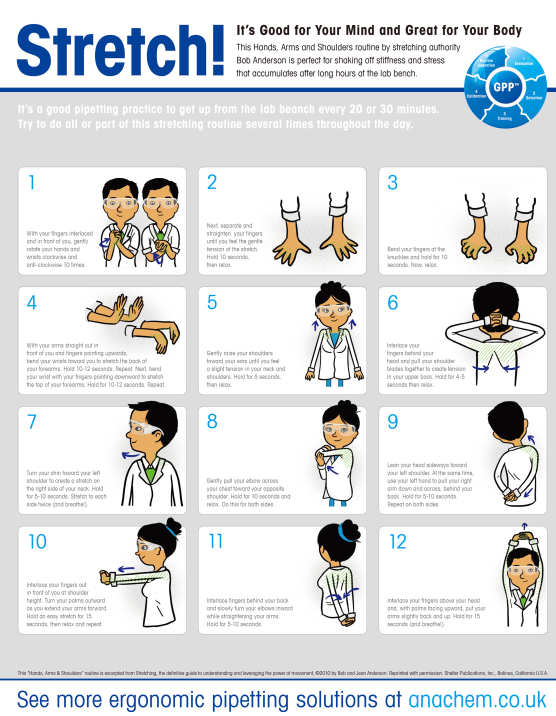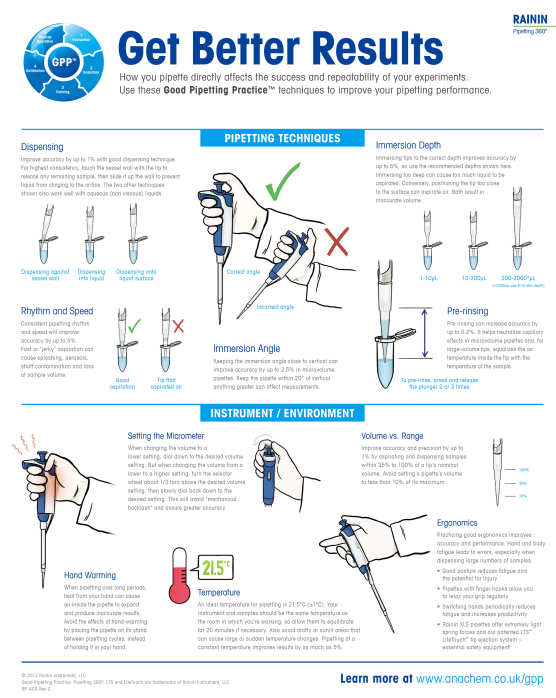Pipette Safety & Ergonomics
Overuse of an automatic pipette can cause teno-synovitis, a painful disabling inflammation of the thumb tendons. It can mean weeks away from experimental work, disrupting your research programme. Several cases occur every year amongst bio-medical researchers in College.
Watch the video to learn how to avoid teno-synovitis.
Automatic pipettes
- Organise your work
- Organise your bench
- Holding your pipettes
- Don't ignore symptoms
- Choosing pipettes
Plan things so that you will not be pipetting for more than 10-15 minutes at a stretch. This will reduce the hours spent on lab work without breaks.
- Intersperse pipetting with other tasks
- Alternate lab work with other activities
- Take your breaks!
If you do have a long pipetting run, use an electronic pipette, or time it so that it is followed by a decent break— the last activity before your lunch-break, for example.
A comfortable working position means your muscles & tendons are less likely to get tensed up and damaged. The length of most automatic pipettes means you may have to position yourself Higher in relation to your working surface than for other tasks.
- Sit or stand so that your forearms are roughly horizontal to the benchtop when using the pipette. Use a high lab stool or lowered bench surface if necessary to achieve this
- Keep your work area tidy— make sure there is sufficient clear space to do the job
- Avoid having to repeatedly twist round to carry out parts of your procedure
- Position your stock of tips and discard container so you don’t have to stretch out to use them
Using your pipettes with a light touch and varying how you hold and operate them, helps lessen and spread out the load on your tendons.
- Don’t press harder than you need to on the plunger
- Try holding your pipettes with a variety of grips
- Use a variety of different pipettes
- Try using your other hand
- Use electronic pipettes for long runs of identical dispensing or filling multi-well plates
The early symptoms of teno-synovitis are usually aching in the forearm muscles, perhaps first coming on after an unusually long day or intense period of lab work. The tendons on the thumb side of the wrist may feel sore, or feel a bit stiff on waking in the morning. Established teno-synovitis causes pain or swelling over the wrist tendons; gripping with the thumb becomes painful and you may feel, or hear a creak over the tendon. Early symptoms should not be ignored.
- If you do get warning signs, take a break from pipetting for a few days, or reduce the amount of pipetting work you do
- Review your schedule to spread out work that uses the pipette
- If symptoms persist or recur, seek help from your local occupational health clinic. The nurses or physician can advise on treatment if needed and help you sort out how to avoid further problems
There’s no perfect type of automatic pipettes. All available models have inherent design faults. If you are buying pipettes, consider purchasing a variety of models and these design points:
- Plunger pressure: the lower, the better
- Length of plunger travel: the less the better
- Tip ejector: select a model with a tip ejector that is comfortable to use. If it can be finger-operated, the loading on the thumb tendons will be less
- Grip: is the pipette comfortable to hold?
- Overall length: again, the less, the better
- Electronic models: higher cost and often less versatile, but much less work for your thumb



